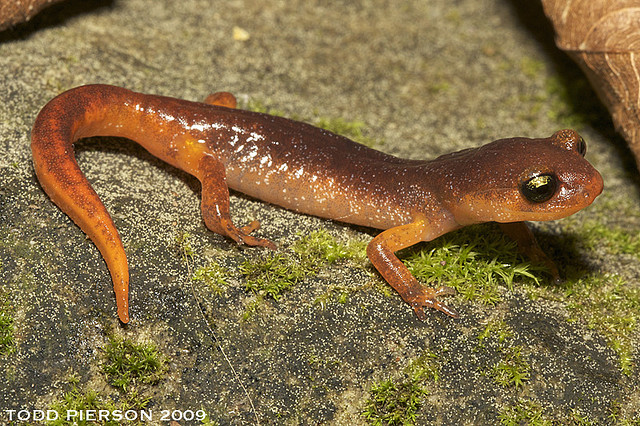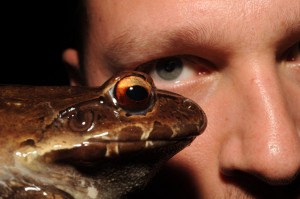“Salamander” is Greek for “fire lizard,” and arises from the belief that a yellow and black Eurasian species, S. salamandra, could live in fire.
“Newt” comes from the Middle English word, “eute,” which refers to the European newt, Triturus. Other etymologies can be less straightforward.
The congo or conger eel, a southeastern swamp species, was misnamed for marine fish because of its legs are tiny and vestigial. “Congo” comes from the Old Norse word “kokkr,” meaning “ball” and may or may not refer to the species’ tendency to coil up like a snake. Nobody knows how the hellbender, a large, very primitive species of eastern highland streams, got its name. One theory is that early European settlers likened its undulations to damned souls’ writhing in hell.
Bay Area salamander common names are less mysterious and often describe the species’ habits or appearance—the arboreal salamander climbs trees, the tiger salamander is yellow and black etc. Their scientific names are stranger because of a historical circumstance. Taxonomists in the eastern U.S. or Europe named most of them from preserved specimens in the nineteenth century. Some may never have seen a living individual of the species they named. So the Greek and Latin names can be surprising.
Our yellow-eyed ensatina is an example. Ensatina, the scientific genus name, is Latin for “sword-shaped,” not overall very descriptive of the Bay Area’s little brown and orange amphibian. It refers to the teeth. The giant salamander’s name, Dicamptodon ensatus, translates as “two curved bent teeth– sword shaped” in Greek and Latin.
An odder example is the arboreal salamander’s label, bestowed in Philadelphia in 1849. The genus name, Aneides, is Greek for “shapeless thing” and the species name seems equally derogatory, lugubris— Latin for “gloomy.” The 1833 genus name for our two Bay Area newt species is even less flattering: Taricha translates as “preserved mummy” in Latin. The pickled specimens used to name both genera probably did look glumly shapeless and mummy-like. But even etymologists aren’t sure what some of the old scientific names are about.
The tiger salamander and its many relatives got their genus name, Ambystoma, in London in 1853. It may be a variation of the Greek term “Anabystoma,” meaning “cram into the mouth” or of the Greek term “Amblystoma,” meaning “blunt mouth.”
All the early scientific names aren’t so strange. Our slender salamander got its genus name the same year as our newts, 1833. Batrachoseps is Greek for “frog lizard,” which at least conveys the basic concept that salamanders are (mostly) more or less lizard-shaped amphibians.
Read more about salamanders in Bay Nature Magazine’s upcoming winter issue, where David Rains Wallace writes the cover story,”The Land of the Salamander,” an ode to the amphibian with more kinds in North American than any other continent.




-300x221.jpg)
-300x206.jpg)